“Good Morning, Bellevue Breakfast Rotarians!” sounded out Miss Jenny! Yee haw! Jenny noted that Manfred Markevitch — one of our former members — is visiting from Switzerland!! Welcome, Manfred!

Bob Bowen
Bob Bowen brought us the following thought and story for our consideration:
- Christopher Wren was the architect who designed some of the most magnificent churches and cathedrals in the world. He was
- the one who facilitated the construction of the great St. Paul’s Cathedral in London.
- While the cathedral was being built, Wren took a tour of the work site and asked the various artisans about their labor. As he left the cathedral, he saw an old man mixing cement in a mortar box, and he asked, “What are you doing, sir?” The man, not recognizing it was Wren who asked the question, said proudly, “What I am doing? Why, sire, I am building a great cathedral!”
- Now there’s a godly attitude toward work. That cement mixer saw what he was doing as a part of a larger plan that gave his humble labors incredible significance. Our prayer today, would that we all could see our labors as part of the Great Architect of the universe, and therein find our significance, too.
- May we as Rotarians humble ourselves like the cement mixer to establish significance in service above self always, and walking in compassion and justice towards our fellow man. ~ Amen

John Martinka
John Martinka introduced visiting Rotarians and guests. Before he began, he asked Rourke O’Brien to stand.
Rourke, the consummate Irishman, lives, breathes and bleeds green! So, the question for our guests was: “What advice would you have for Rourke for this upcoming St. Patrick’s Day?”
One response to the question was to “Drink Miller Lite!” Frank Young — wearing his green jacket — said, “Get a green jacket!”
At the end, John had the entire room repeat the “official BBRC saying” — “You are all always welcome at the Bellevue Breakfast Rotary Club!”

Cary Kopczynski
Cary Kopczynski, Dick Brown, Kim Shrader (with his new goatee) and Norm Johnson — the members of the Rotary Foundation Committee — came forward to present awards and pins to the following members:
- David Bolson, $2,000 – 1 Sapphire Pin
- Steve Luplow, $3,000 – 2 Sapphire Pin
- Kevin Jewell, $4,000 – 3 Sapphire Pin
- Bob Vallat, $4,000 – 3 Sapphire Pin
- Paul Chapman, $5,000 – 4 Sapphire Pin
- Steve Goldfarb, $7,000 – 1 Ruby Pin
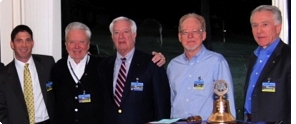 L-R: Steve Goldfarb, Dick Brown, Bob Vallat, Kim Shrader & Cary Kopczynski
L-R: Steve Goldfarb, Dick Brown, Bob Vallat, Kim Shrader & Cary Kopczynski
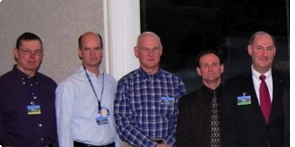 L-R: Norm Johnson, Paul Chapman, Kevin Jewell, Steve Luplow & David Bolson
L-R: Norm Johnson, Paul Chapman, Kevin Jewell, Steve Luplow & David Bolson
Way to go, guys! Thanks for all you do and give!
Bellevue 5K Run/Walk Supports Kindering

Jane Kuechle
Jane Kuechle, Chair for this year’s Bellevue 5K Run/Walk, reminded us that some of the 5K proceeds will be given to support Kindering (no longer called Kindering Center).
Jane noted that the 5K Committee has given us some awesome tools to help get the word out for the Run/Walk and ultimately bring in the bucks to help Kindering and BBRC’s good work.
We now have available to us:
- Postcards
- Trifold Brochures (plenty of them!)
- A Poster (new!)
- E-vite
Jane specifically thanked Kaj Pedersen for his fantastic PR help!
In order to help us all get a better sense of what Kindering does for families and children on the Eastside, Jane invited Mr. Gregg Benn to come up and speak to us about his own experiences with Kindering.

Gregg Benn
Gregg gave a moving story about his daughter, Claire, and her struggle early in life —at one week — when doctors said that she had a rare genetic disorder called Prader-Willi Syndrome (or PWS). Doctors said Claire might never be able to walk, might need a feeding tube for six months to a year, would have a future of morbid obesity and metabolic rate problems, and have cognitive challenges and learning disabilities.
Gregg portrayed that moment as: “The bubble pops; the dream is crushed.” All the things he imagined for his daughter were destroyed. He was devastated and had a moment of lost hope.
Someone told Gregg about Kindering and he called them. They told Gregg to get his daughter into the program as soon as possible, and they laid out a plan for Claire, with the number one objective being to get her off the feeding tube. By the time she was 3-4 months, Claire was off the feeding tube and onto a bottle — the beginning of a great experience, Gregg said.
For social, speaking and cognitive abilities, Kindering staff again laid out a plan and provided tools to help Gregg, his daughter and his support group.
Gregg expounded on two things about Kindering which meant a lot to him: first, he never had to worry about paying for any of the help; secondly, Kindering is a “holistic” place for solutions.
Gregg said that his interface at Kindering helped him get connected to the Washington State Father’s Network to help him get the resources needed to learn that there is a future, and you can feel more comfortable with the circumstances.
In conclusion, Gregg said that Kindering gave him hope, renewed his dreams for his daughter, and he now can see a whole future open for Claire. Gregg also said, "It is wonderful that Rotary is supporting Kindering! Thank you and thank you for the opportunity to speak!”
Thanks, Gregg, you are a very heroic man! Our best wishes to you for you, your family and your daughter.
Student of the Month — Kayla Blau


SOTM Kayla Blau & Bob Holert
Bob Holert introduced the Student of the Month, Kayla Blau, from Sammamish High School. She was accompanied by her dad Len Blau and Laura Klein, her counselor at Sammamish.
Kayla has a remarkable resume at Sammamish, one to be proud of. She plays varsity basketball and just received the “Heart and Hustle” award. She is also on the varsity tennis, track, swim and dive teams and is vice president of the Spirit Club.
Kayla’s community service includes over 200 hours of work, including time at Hopelink and the 24 Hour Relay for Life.
Bob reported that Kayla’s teachers are delighted with Kayla. They can count on her, and she remains focused on school today, while her other classmates have their minds set on next year ... not graduation! Way to go, Kayla!
Kayla thanked the BBRC for the honor, saying she was very grateful to receive it. Kayla said that she will be attending University of San Francisco, with plans to study psychology and law.
Of note, Kayla’s brother received some scholarship money from the BBRC three or four years ago, so the BBRC tradition continues in the Blau family.
Mini Assembly: Club Administration
The mini assembly focused on the Club Administration Committee, which includes includes the Program Committee, led by Chris Monger, and the Fellowship Committee, led by Steve Lingenbrink.

Chris Monger
Program Committee
Chris explained that the purpose of the Program Committee is to bring great programs to our meetings, to help us get inspired by stories, and keep everyone coming back. Chris had the committee members stand up for recognition and thanks to those who have helped out with bringing in great speakers.
Chris asked everyone to tell him or any committee member if they have ideas for great speaker s. Chris also made the pitch to join the Program Committee — he said they rarely meet, and you are not inundated with email!

Steve Lingenbrink
Fellowship Committee
Steve Lingenbrink talked about the Fellowship Committee, with “uber thanks” to Ron and Stella Black and Wendi Fischer — they have been terrific and supportive!
Here is the upcoming schedule, so MARK YOUR CALENDARS NOW!
- March 20 - BBRC Retreat, Leavenworth
- May 1-3 - District Conference, Victoria, BC
- May 21 - BBRC Beer Tasting Event, home of John & Jan Martinka
- June 5 - Disco Fever Dance Party, Wendi Fischer’s House, Redmond
- June 26 - “Jenny’s Turkish Bath House” - Rotating the Wheels Dinner, Trilogy Golf Club, Redmond
Of course, we will continue the 3rd Thursday Socials (most of them are at the Rock Bottom). Check the calendar!
Three Members Proposed: Anderson-Barnes, Morant & Osborn
Ashley Anderson-Barnes is a doctor of chiropractic medicine, practicing at WellnessOne of Bellevue. She is sponsored by Steve Lingenbrink, and her proposed classification is Chiropractic Healthcare.
Community service was always in Ashley's mind, as her family encouraged her to be involved in helping others. One of her relatives recommended Rotary above all other service organization, and she has been waiting just long enough to settle in Bellevue to jump in.
Ashley lives in Issaquah with her husband Jeff Barnes, and she has been involved in the Seattle Pet Therapy Group, Eastside Women in Business, and the Eastside Entrepreneurs Social Network, just to name a few. Her hobbies and interests include hiking, scuba diving, golfing, motorcycle riding, and playing with as many dogs as possible.
• • •
Celia Morant has been with Microsoft since 1995 and is Senior Director of Connectivity Services. Her proposed classification is IT Maven.
Celia has been a supporter of United Way and been looking for an organization in which to get involved. Celia is a member of the Women in Technology and the Women in IT of Microsoft, and she lives in Mercer Island with her husband and three children.
Celia and Christine Addison have been close friends since high school, and she has heard a lot about the BBRC from Christine and decided that this was the club for her.
• • •
Paul Osborn is Project Manager & Process Engineer at Broker Research Technologies in Redmond. His sponsor is Kaj Pedersen with whom he worked previously.
Paul has visited our club many times now and is eager to become a member. He lives in Redmond with his wife Teresa, and his hobbies include mountain biking and kayaking, among other activities.
Paul's proposed classification is Software Product Management.
Get your Treehouse receipts from Madeline Gauthier.
John Martinka announced that 225 computers, 4 industrial sewing machines, and 900 British English dictionaries have been shipped to Antigua.
Court Lorenzini, Primus BioVision, an Interesting Twist on the Possibilities for Biofuel Production in the US
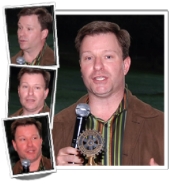
Chris Monger introduced our speaker, but first noted tha t our original speaker, Mr. Michael Medved, had to cancel due to a death in his family. Roger Allington, someone who’s had his own recent medical issues, pitched in and brought in a speaker. Thanks, Roger! That is Service Above Self!
Primus BioVision is headquartered in Seattle and has Network facilities across the US and Europe. They help meat packers maximize their profit per head by turning their natural byproduct stream into a highly profitable biofuel business on-site. Their turnkey biodiesel operations are designed specifically for the meat packing industry. They design, build, staff, operate and maintain the fuel business so that slaughterhouse operators can stay focused on packing and processing.
Court began his talk explaining the focus on biofuels. The US Government is trying to get the US to be less reliant on overseas fuel sources, and this is one way to do it.
Ethanol & Biofuels
Court calls ethanol production “legal moonshining,” where you convert corn into ethanol, which is added to gasoline. Unfortunately, ethanol’s “energy density” is quite low, so for each gallon of ethanol, you are not getting much energy back, as compared to gasoline or diesel fuel.
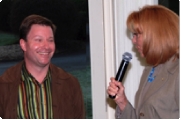
Court Lorenzini & President Jenny Andrews
Also, as there is an increased push on making ethanol, the demand on corn and other feed stocks causes the prices to rise and results in the price of food going up. Overall, this is an expensive process, with undesired results.
A new type of ethanol with higher energy density is coming but not for another 5 or 10 years.
Biodiesel
Biodiesel can be viewed as a carbon-based oil with the same chemical composition as the oil from the ground (not like ethanol, which is sugar). Biodiesel has the same energy density as petroleum, but it burns cleaner than oil and has a higher level of “lubricity” for engines, thus helping them have a longer service life.
Additionally, Biodiesel does not require modifications to engines to make them work; ethanol does.
The Biodiesel market is still in its early stages and has many economic challenges. For instance, the plant in Grays Harbor — which is using vegetable stock to make fuel — is downsizing, mainly because the European market — where there is a biodiesel demand —has a large tariff, and they Grays Harbor operation cannot make any money
One way to get around some of the economic hurdles is to move away from vegetable stock and go towards used cooking oils, animal fats, and residual animal parts left over after slaughter.
So, why use animal fat? It is less expensive than vegetable oil, the animal “stuff” is inedible, there is no value for this “stuff” on the market, and you do not need any new technologies to render the animal fats into fuel.
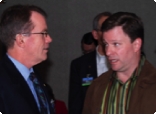
Chris Monger & Court Lorenzini
BioVision is also looking hard at the supply chain and how to reduce costs to make the fuel where the raw material is created, basically, at the “Chop Shop,” or slaughter house.
Consider the following for BioVision:
Solution is already optimized for the meat packing industry
Their approach is the only solution capable of turning raw byproduct straight into fuel on-site
The process is “right-sized” to fit the slaughter house’s specific kill rate
Pre-engineered facility and process technology lowers start-up costs
Joint venture business model tailored to maximize operating profit in both packing and fuel
How are they taking advantage of this situation? Lorenzini noted the following:
- #1: They offer a partnership to the slaughterhouse. They bring the business to the plant and then share in the upside. Primus BioVision has ready access to the raw material (while it is fresh and not oxidized), and they can increase their profitability by two-fold.
- #2: The refinery process is fairly small scale, unlike the regular oil industry, with a small number of large plants. Also, the refineries can be near the slaughterhouses which are usually located in rural locations.
- #3: The transportation cost is reduced. They don’t need to move product long distances to process, thus improving the business margin.
- #4: The refinery can do more than one thing and make more than one product from the raw materials.
In summary, they see lots of potential, and their focus is not on “bad” technology, but instead on building a business process that is focused on the supply chain.
Q&A From the Floor:
- Q: Having built the plants, how can they guarantee a supply of the raw materials?
- A: We are tied to business. We guarantee supply, but also have secondary raw material flow contracts set up.
- Q: How far along is the development of the company?
- A: We are getting ready to build the first plant, and it os planned for three companies right away.
- Q: What about the long-term future of ethanol?
- A: Not a fan. There are so many drawbacks, e.g., domestic supply and renewable, but really a stopgap measure and not a long-term solution.
- Q: Will it result in an increased cost of dog food?
- A: No, we use the fats not the protein.
- Q: What is the impact if you convert 100% of raw material into biofuel?
- A: From a world perspective, we could make about 10 billion gallons a year; however, the US uses 60 billion gallons of diesel a year. So, even though the impact is still only 1/6 of the US consumption, it would still help reduce wastes into the environment and help reduce dollars going overseas.
- Q: What is the physical size of plant?
- A: 10,000 sq feet plus a tank farm.
- Q: Right now, what is being done with the fats/oils that you would be using in your processes?
- A: They are being sent to China and turned into candles and soaps.
Of note, early in the presentation, Court said that his third daughter has Prader-Willi Syndrome, so he had a lot of empathy for Gregg Benn.
President Jenny thanked Court for his talk and announced that a contribution in his name would be made to Polio Plus.
Courtesy of Steve Lingenbrink
One of these people is a current BBRC member. Can you guess which one?







